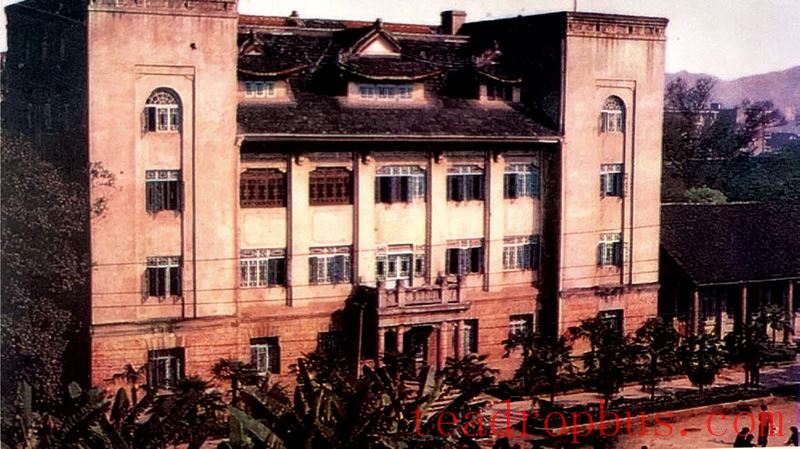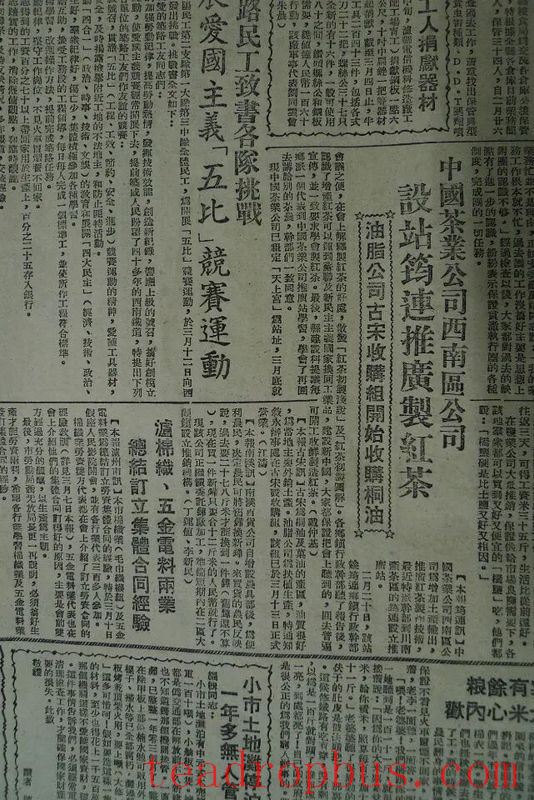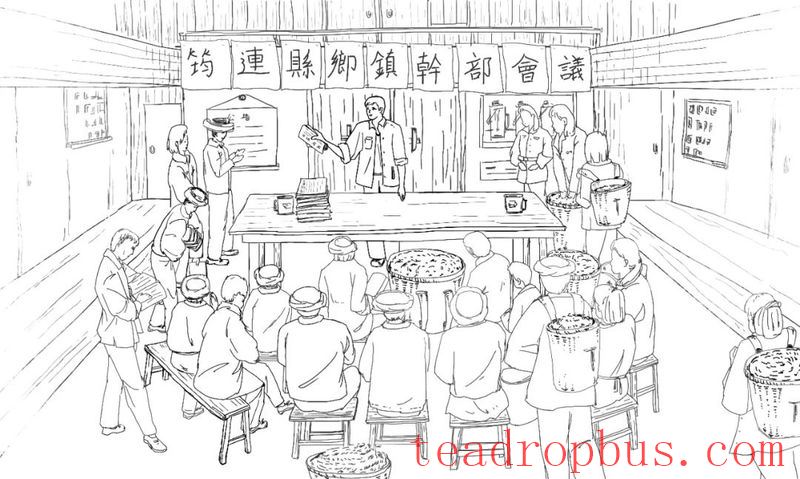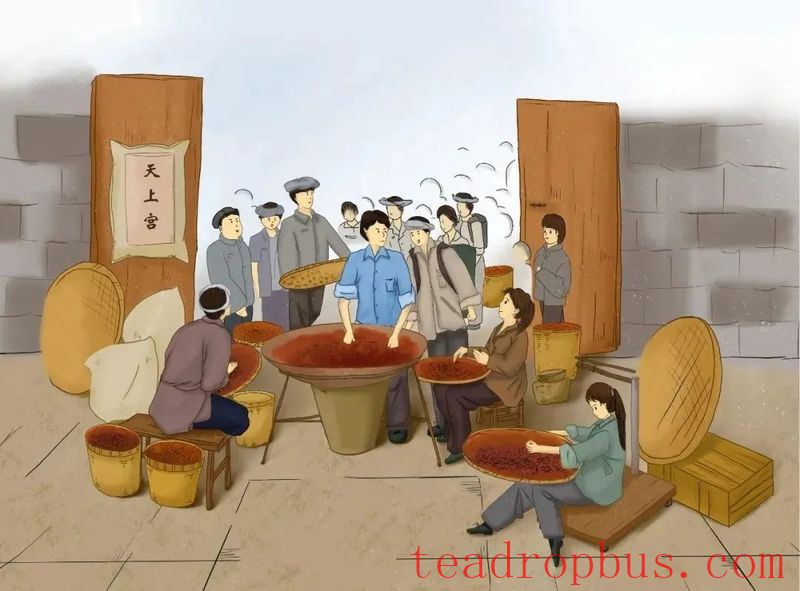We found an issue of the Chuan Nan Daily from February 22, 1951, containing a report about Sichuan Black Tea.

The original building of the Chuan Nan Administrative Public Office in Luzhou
In October 1949, when the People's Republic of China was founded, Sichuan Province had not yet been liberated. At the end of 1949, Chiang Kai-shek's Nationalist government retreated to Chongqing and Chengdu, making Sichuan the last stronghold of the Nationalist regime on the mainland. After Sichuan's liberation, due to the need for anti-bandit operations, in January 1950, the State Council decided to dissolve Sichuan Province and divide it into four administrative offices: Chuan Nan, Chuan Bei, Chuan Dong, and Chuan Xi. The Chuan Nan Administrative Public Office was located in Luzhou City, overseeing one city (Zigong), four special administrative regions (Luzhou, Yibin, Neijiang, Leshan), and 42 counties. The Chuan Nan Daily, published by the Chuan Nan Administrative Public Office, served as a provincial newspaper akin to today's Sichuan Daily.
The report, titled “China Tea Corporation Southwest Branch Establishes Station in Yunlian to Promote Black Tea Production,” is as follows:

Report from the Chuan Nan Daily on February 22, 1951
YUNLIAN, our correspondent – To increase local produce exports and promote black tea production techniques, the China Tea Corporation Southwest Branch recently sent staff to establish a promotion station in the tea-producing area of Yunlian in Chuan Nan.
On February 20th, the station took advantage of a town cadre meeting in Yunlian to explain the benefits of black tea production and distribute “A Brief Introduction to Black Tea processing” and “Illustrated Guide to Initial Black Tea Processing.” After hearing the report, town cadres recognized that increasing black tea production could facilitate trade with the Soviet Union and new democratic countries, bringing back industrial goods to build the new China. They all pledged to widely publicize what they learned at the meeting and expressed a unanimous desire to learn how to make black tea. Recently, the county construction department proposed that each town send a representative to learn from the China Tea Corporation promotion station, who would then teach other tea farmers. This proposal was met with unanimous agreement.
The China Tea Corporation has now determined “Tianshigong” as the site for the station, which will begin operations to collect fresh leaves and manufacture black tea by the end of March (Dai Zhongji).

Dai Xinyong promoting black tea production during a town cadre meeting in Yunlian County
Of the seven black tea promotion stations established by the China Tea Corporation Southwest Branch in Sichuan, Yunlian County's station was ranked first and was the only “county station” and “main station.” Additionally, Luo Chang Town in Gao County, adjacent to Yunlian, also had its own station with Dai Xinyong as the station chief. As a result, the two stations often worked together. Dai Xinyong was the first graduate of the Tea Specialty program at Fudan University's College of Agriculture and a promising student of Wu Jue'nan. When the Yunlian County Black Tea Promotion Main Station was established, it had been less than four months since the suppression of bandits and rebels, highlighting the urgency of developing black tea production at the time.
The Yunlian County Black Tea Promotion Main Station was set up at “Tianshigong.” Located south of the old city of Yunlian, “Tianshigong” was the site of the Yunlian County Tea Industry Guild during the Republican era and served as a place for tea industry professionals to collect, process, exchange, and discuss business. “Tianshigong,” also known as the Fujian Guildhall, was established by immigrants from Fujian, the birthplace of the world's earliest black tea.

First production of Sichuan black tea (illustration)
In early spring 1951, Yunlian County saw an early large-scale harvest of fresh tea leaves. On April 20th of the same year, the first demonstration of black tea processing in Sichuan was held at Tianshigong in Yunlian City. More than fifty tea farmers from Yunlian County and nearby Luo Chang in Gao County observed the demonstration. Dai Xinyong, the station chief of both Yunlian County and Luo Chang Township black tea promotion stations, demonstrated the entire process of black tea production, including withering, rolling, fermentation, and drying. The resulting black tea had bright colors, fine and elegant shapes, sharp peaks, and a red and lustrous infusion, markedly different from the Green Tea produced previously. “Tea can be made like this!” “Teacher Dai, when will you come to Xunsi to teach us?” The black tea production technique was enthusiastically received.

Station Chief Dai Xinyong teaching tea farmers to pick “one bud and two leaves” for black tea production (illustration)
The promotion station adopted various methods, such as training courses, chalkboards, lectures at meetings, folk songs and rhymes, and field demonstrations, to promote the cultivation, picking, and processing techniques of black tea. As a result, black tea rapidly spread throughout Yunlian County, Gao County, and surrounding areas. However, the products produced at the time were still crude black tea, rather than the refined black tea that came later. Meanwhile, Gao County and Yibin County also began promoting and producing black tea. In the autumn of that year, the crude black tea produced in Yunlian, Gao County, and Yibin County was transported via horse caravans and wooden boats to Yibin. From there, it was shipped to Chongqing, the headquarters of the China Tea Corporation Southwest Branch. After further refinement in Chongqing, the tea was shipped via waterway to Wuhan, then by train northward through Zhengzhou, Beijing, Shenyang, Harbin, and Manzhouli, finally reaching the Soviet Union. Thus, in 1951, a new tea brand – “Sichuan Black Tea” (shortened to “Chuan Hong”) – was born. Later, the hand-refined “Chuan Hong Gongfu” became the name for the premium product within “Chuan Hong.”
The Story of Yibin's “Chuan Hong Gongfu” Black Tea:
Part One: The History of Tea Production in Yibin Before the Ming dynasty
Part Two: Records of Yibin Tea in the Ming Veritable Records
Part Three: The Emergence of the Prototype of “Chuan Hong Gongfu” Black Tea
Part Four: The Establishment of Three Yibin Black Tea Promotion Stations
Part Seven: The Establishment of the Yibin Tea Factory
If there are any copyright issues, please contact us for deletion.